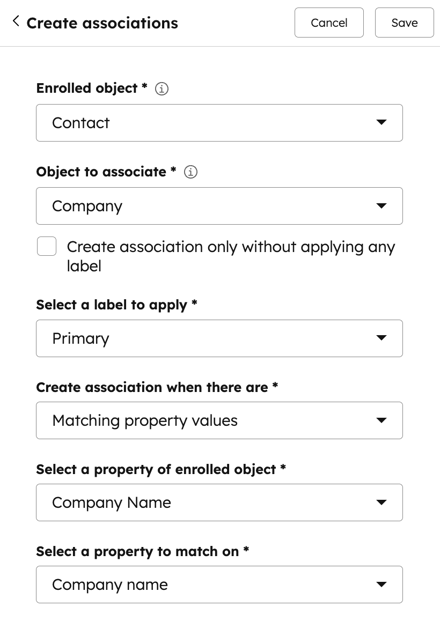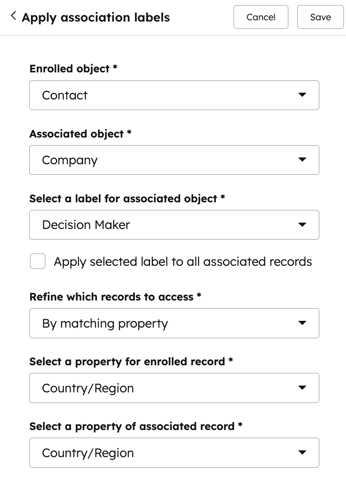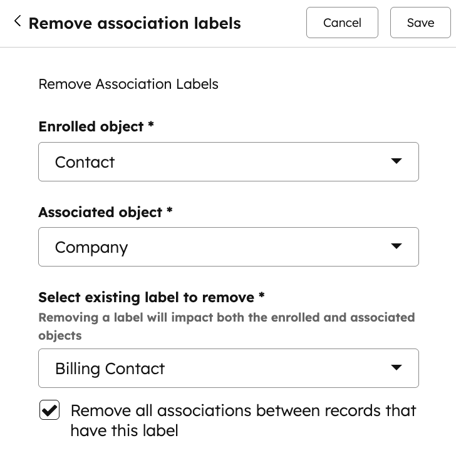- Knowledge Base
- Automation
- Workflows
- Manage CRM record associations with workflows
Manage CRM record associations with workflows
Last updated: November 3, 2025
Available with any of the following subscriptions, except where noted:
-
Marketing Hub Professional, Enterprise
-
Sales Hub Professional, Enterprise
-
Service Hub Professional, Enterprise
-
Data Hub Professional, Enterprise
-
Smart CRM Professional, Enterprise
-
Commerce Hub Professional, Enterprise
Use workflows to automate the management of your records' association labels and create new associations.
Please note: the following actions are available for contact, company, deal, ticket, lead, appointments, courses, listings, services, and custom-object workflows. These actions cannot be used with other objects such as products, quotes, etc.
Create new associations between records
Use this action to create new associations within CRM records. For example, you can create associations between contacts and companies when they have matching Company name property values.
To create a new association:
- In your HubSpot account, navigate to Automation > Workflows.
- Click the name of an existing workflow or create a new workflow.
- Set your enrollment triggers.
- Click the + plus icon to add an action.
- In the left panel, click to expand the CRM section. Then, click Create associations.
- Configure your Create associations action details:
- Enrolled object: this will be set to the workflow's object type by default. For example, if you've created a contact-based workflow, this will be set to Contact enrolled.
- Object to associate: the object type of the record to be associated with the enrolled record.
- Create association only without applying any label: select this checkbox to associate records without applying an association label.
- Select a label to apply: select the association label to be applied to the newly associated record. This option will only appear if you've chosen to create an association with an association label.
- Create association when there are: for the Create associations action, select the Matching property values option.
- When matching properties between records, only property values will be used for deciding the match. Generally, the label and internal name of the properties selected will not be used for matching, except for enumeration properties where the internal name will be used for matching.
- For example, if a contact has a City property with the value Boston, and a company has a Location property with the value Boston, the contact and the company will be matched and an association will be created.
- Alternatively, if a contact has a City enumeration property with the label Boston Logan International Airport and the internal name Boston, Boston will be used for property value matching.
- Select a property of enrolled record: select a property from the enrolled record to be matched with a corresponding property from the record to be associated.
- Select a property to match on: choose a property from the record to be linked to a matching property from the enrolled record.
- After setting up your Create associations action, at the top, click Save.
Please note:
- You can only use single-line text, multi-line text, phone number, number, single checkbox, and single select (e.g., radio button) properties when matching records to create associations.
- When matching records, the property values used are case-sensitive and must match exactly. For example, if the contact's Company name property value is hubspot, but the company's Name property value is HubSpot, the records will not be matched and the association will not be created.
- This action has a daily limit of 5 million action executions, which includes action execution failures. If you haven't selected the Create association only without applying any label checkbox, an association label will be added to your newly created association, and the action will count as 2 executions towards the limit.

Apply association labels to a record
Use this action to apply an association label to already associated records. You can choose to apply association labels to all associated records of a certain object type or further refine which associated records to apply the association label.
- In your HubSpot account, navigate to Automation > Workflows.
- Click the name of an existing workflow or create a new workflow.
- Set your enrollment triggers.
- Click the + plus icon to add an action.
- In the left panel, click to expand the CRM section. Then, click Apply association labels.
- Configure your Apply association label action details:
- Enrolled object: this will be set to the workflow's object type by default. For example, if you've created a contact-based workflow, this will be set to Contact enrolled.
- Associated object: the object type of records associated with the enrolled record. Only objects with defined association labels will appear.
- Select label for associated object: the association label to be applied to the associated records.
- Apply selected label to all associated records: select this checkbox to apply the association label to all records of the selected object type associated with the enrolled record.
- Refine which records to access: choose to refine which associated records the action will apply to. This field will only appear if the Apply selected label to all associated records has not been selected.
- By matching property: the association label will only be applied when the specified property's value matches the corresponding property's value in the enrolled record. For example, you may only want to set a Decision maker when both the contact and associated company have the same Country/Region property value.
- Select a property for the enrolled record: select a property from the enrolled record to be matched with a corresponding property from the associated record.
- Select a property of associated record: select a property from the associated record to be matched with a corresponding property from the enrolled record.
- By matching property: the association label will only be applied when the specified property's value matches the corresponding property's value in the enrolled record. For example, you may only want to set a Decision maker when both the contact and associated company have the same Country/Region property value.
Please note: when matching properties between records, only property values will be used for determining the match. The label and internal name of the properties selected will not be used for matching. Generally, the label and internal name of the properties selected will not be used for matching, except for enumeration properties where the internal name will be used for matching. For example, if a contact has a City property with the value Boston, and a company has a Location property with the value Boston, the contact and the company will be matched and an association will be created.

-
-
- By property value of enrolled record: the association label will only be applied when the enrolled record meets the requirements of the specified property values. For example, you may only want to apply an association label of Decision maker when the enrolled company has more than five employees.
- Select a property of enrolled record: select a property from the enrolled record.
- Operator: select from is equal to or is not equal to operators
- Enrolled record input value: select or enter a property value to be used with the operator.
- By property value of enrolled record: the association label will only be applied when the enrolled record meets the requirements of the specified property values. For example, you may only want to apply an association label of Decision maker when the enrolled company has more than five employees.
-

-
-
- By property value of associated record: the association label will only be applied when the associated record meets the requirements of the specified property values. For example, you may want to apply an association label of Decision maker only when the contact's Job Title property has been set to Manager.
- Select a property of associated record: select a property from the associated record.
- Operator: select from is equal to or is not equal to operators
- Associated record input value: select or enter a property value to be used with the operator.
- By property value of associated record: the association label will only be applied when the associated record meets the requirements of the specified property values. For example, you may want to apply an association label of Decision maker only when the contact's Job Title property has been set to Manager.
-
- After setting up your Create associations action, at the top, click Save.

Update your record's association labels
To replace your existing association label or append a new association label to the associated record:- In your HubSpot account, navigate to Automation > Workflows.
- Click the name of an existing workflow or create a new workflow.
- Set your enrollment triggers.
- Click the + plus icon to add an action.
- In the left panel, click to expand the CRM section. Then, click Update association labels.
- Configure your Update association label action details:
- Enrolled object: this will be set to the workflow's object type by default. For example, if you've created a contact-based workflow, this will be set to Contact enrolled.
- Associated object: the object associated with the record. Only objects with defined association labels will appear.
- Select existing label: the current association label used to associate the different records.
- Add to or replace existing label: you can choose to add to or replace the existing association label.
- Add to existing label: add an association label to the existing association label. For example, if a contact currently has an association label of Primary, adding a Decision maker association label will update the contacts associated with the enrolled records to Primary and Decision maker association label.
- Replace an existing label: clear the existing association label and add a new association label. For example, if a contact currently has a custom association label of Additional contact, choosing this action with a Decision maker association label will update the contacts associated with the enrolled records to Decision maker association label only. You cannot use this action to replace any primary association labels such as the default Primary association label.
- Select label to append to or Replace existing label with: select the new association label to append or replace the existing association label with.
- After setting up your Update association label action, at the top, click Save.

Remove your record's association labels
To clear your existing association labels:- In your HubSpot account, navigate to Automation > Workflows.
- Click the name of an existing workflow or create a new workflow.
- Set your enrollment triggers.
- Click the + plus icon to add an action.
- In the left panel, click to expand the CRM section. Then, click Remove association labels.
- Configure your Remove association labels action details:
- Enrolled object: this will be set to the workflow's object type by default. For example, if you've created a contact-based workflow, this will be set to Contact enrolled.
- Associated object: the object associated to the record. Only objects with defined association labels will appear.
- Select existing labels to remove: select the association labels to remove from both the enrolled and associated objects.
- Remove existing associations with this label: select this checkbox to remove the associations between the records.
- After setting up your Update association label action, at the top, click Save.
Please note: this action has a daily limit of 5 million action executions, including action execution failures.
